This is a Minolta AF-Sv, a 35mm point and shoot, fully automatic camera made in Japan by Minolta starting in 1984. Known by it’s nickname “the Talker”, the AF-Sv is notable as having a voice feature in which the camera can play back voice alerts as reminders for things like remembering to load film, that the exposure is too dark, or to check the distance. Without the voice feature, the AF-Sv is identical to the non-talking Minolta AF-S which had a 4-element 35mm f/2.8 lens, fully programmed auto exposure, active autofocus, automatic film loading, and an in body automatic flash. The camera was heavily promoted as being “from the mind of Minolta” which they used frequently as a marketing slogan to promote a variety of innovative and clever features.
Film Type: 135 (35mm)
Lens: 35mm f/2.8 Minolta Rokkor coated 4-elements in 3-groups
Focus: Active Auto Focus, 0.8 meters to Infinity
Viewfinder: Scale Focus Reverse Galilean with Albada type frame lines, LED flash and focus confirmation
Shutter: Seiko Electronic Two Blade
Speeds: 1/8 – 1/625 seconds, Fully Automatic
Exposure Meter: Coupled CdS Cell w/ Full Programmed AE
Battery: (2x) 1.5v AA Battery
Flash Mount: In-body Popup Flash, X-sync 1/40 seconds
Weight: 363 grams (with batteries and lens cap), 308 grams (without)
Manual: None
How these ratings work |
The Minolta AF-Sv “Talker” is an otherwise ordinary mid 80s fully automatic 35mm point and shoot camera with a gimmicky feature that allows the camera to play back one of three voice reminders to warn you of various pitfalls you might encounter while shooting. Whether you get the talking or non-talking versions, both versions feature a 4-element “Tessar style” 35mm lens that consistently delivers good images. The Talker is easy to use and with its semi-wide angle 35mm lens, won’t stress the primitive auto focus system much, making for a dependable camera to stuff in a bag or the center console of your car. | ||||||
| Images | Handling | Features | Viewfinder | Feel & Beauty | History | Age | |
| 2 | 1 | 1 | 1 | 1 | 1 | 0% | |
| Bonus | +1 for simplicity of use, good images, and overall quality | ||||||
| Final Score | 8.0 | ||||||
History
Only from the mind of Minolta…
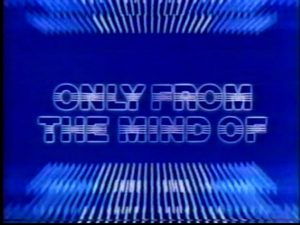
If you watched TV in the 1980s, you likely saw a number of commercials from Minolta with this slogan. Although I was too young at the time to appreciate Minolta’s efforts, as I look back at their history, Minolta seemed to be the Japanese company that pushed the envelope more consistently than the others. That’s not to say that Canon, Nikon, Konica, or any other companies didn’t innovate, but thinking outside the box seemed to be an ethos at Minolta since the very beginning.
Minolta can trace it’s roots back to 1928 when a man named Kazuo Tashima created Nichidoku Shashinki Shōten and enlisted the help of two former German camera technicians to build German inspired Japanese cameras that had equal parts German DNA but with a unique Japanese design. Nichidoku didn’t want to simply copy German cameras, they wanted to make their own. Nichidoku would change it’s name in 1931 to Molta Gōshi-gaisha and the new company would build models inspired by other German makers.
The first Minolta camera was heavily inspired by the Plaubel Makina, but wasn’t an outright copy of it. Both the Minolta and Makina used a scissors folding design with removable backs for sheet and roll film and were aimed at the semi to professional photographer.
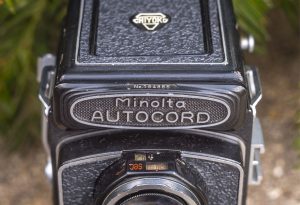
Later cameras like the first Minoltaflex were heavily inspired by the Franke & Heidecke Rolleiflex and Rolleicord TLRs. After world war II when the Minoltaflex became the Autocord, it used a unique bottom focus lever instead of a knob, a bottom hinged film door for easier film loading, and in 1958 a clever take on the LVS metering system in which aperture and shutter speed values are added together to match the correct exposure from a hand held meter.
Many of Minolta’s later cameras had innovative designs and features that weren’t complete departures from established designs, but weren’t copies either. The first Minolta 35 rangefinder borrowed a lot from the Leica, but had a unique viewfinder, front plate design, and hinged film compartment. The Minolta Auto-Wide was one of the first rangefinder cameras with a dedicated wide angle lens rather than a 40-50mm prime. In 1958, Minolta would beat other Japanese companies like Nikon, Canon, Konica, and Yashica to market with their first 35mm SLR, the Minolta SR-2. In 1963, the Minolta SR-7 would be released as the first 35mm SLR with a built in CdS exposure meter. In 1966, the SRT-101 became one of the first SLRs with open aperture through the lens metering and it’s CLC (Contrast Light Compensator) metering system was an early form of matrix, instead of spot or averaging, metering.
In the 1970s, Minolta swung for the fences and paired up with Ernst Leitz, working together on a number of projects that resulted in the Minolta CL in 1973 which was the first non-Leica camera to use the Leica M bayonet lens mount, the Minolta XE-7 in 1974 which was co-developed as the Leica R3, and in 1977 the Minolta XD-11 which was the foundation of the Leica R4 through R7.
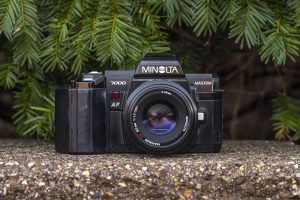
Finally, in the 1980s, Minolta was constantly on the cutting edge of autofocus technology, first with the Minolta X-600 in April 1983 which was a manual focus SLR that used electronic focus assist that would illuminate a light in the viewfinder when sharp focus was obtained, and the Maxxum 7000 in 1985 which was the first successful implementation of in-body automatic focus in a 35mm SLR.
To Minolta’s credit, many of their innovative ideas worked well for the company, selling well and boosting their reputation in the industry. Between the Minoltaflex and Autocord, Minolta produced Rollei inspired TLRs from 1937 to 1966, the SRT-101 was in production from 1966 to 1981, and their Maxxum lineup of autofocus SLRs continued to be produced until Minolta and Konica merged together and eventually sold it’s technology and patents to Sony in 2006.
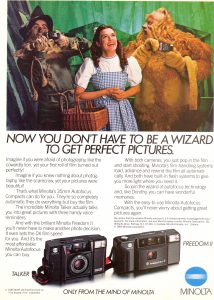
For all of their successes though, Minolta had a few whiffs, such as the Minolta Instant Pro, their lone attempt at an instant camera, which was nothing more than a rebranded Polaroid Spectra. There were two versions of the Minolta 110 Zoom SLR which attempted to combine the compactness of Pocket Instamatic 110 film into a zoom SLR, which resulted in one of the strangest looking cameras of all time. Finally, we had the “Talker” the world’s first talking camera.
Wow! A talking camera, that still sounds futuristic today! None of my Nikon DSLRs or the Fuji X-T20 mirrorless which I use to take all of the beauty pics of cameras for these reviews can talk to me. Wouldn’t it be nice if my camera reminded me that I had set it to -2EV for my last shot and I might want to put it back to 0 for this next shot, or perhaps it could tell me when I’m in range of my home’s wi-fi so that I could start offloading pictures onto the shared drive I have set up for it….you know, essential things!
In all seriousness, there’s probably a reason not many other cameras ever talked, which is that they don’t need to, especially not a fully automatic point and shoot camera from 1983. As you might have guessed, the talking feature was quite limited and gimmicky. With only three things it could say, the camera will remind you if your image is “too dark”, whether or not you forgot to “load film”, or whether you need to “use flash”.
That didn’t stop the people “with the mind of Minolta” from creating clever advertisements like the selection of three TV commercials below suggesting that only with the aide of a talking camera, can photography truly be foolproof.
I quite enjoyed this Japanese language commercial because although I do not speak Japanese, I can pretty much guess what the lady is saying!
When it was released, the camera was sold both as the AF-Sv, and as the Talker. My instinct is to say the Talker branded one was imported to the US and the AF-Sv was sold elsewhere, but looking at the commercials above, the first one does not have the “Talker” logo on the front like the second commercial does. It is hard to get a sense for which version of the name was more common as I believe the term “Talker” was applied to the camera whether it was branded the AF-Sv or as the Talker.
Pro Tip: It’s worth mentioning that if you go searching for one of these cameras on eBay, a lot of non-talking Minolta AF-S cameras are incorrectly being listed as the Talker since they look so similar. The best way to tell them apart is to see if there is a switch on the back door to turn the talking feature on and off.
In a 1984 ad for Executive Photo Supply in New York City, the Talker retailed for $129.50, which when adjusted for inflation, compares to about $325 today. Looking through that same ad, the Minolta was slightly more expensive than similar Konica, Pentax, and Yashica point and shoots, but less than the non-talking Canon Super Sure Shot at $137.50.
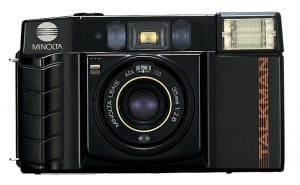
In September 1984, an updated version called the Talkman was released which changed the shape of the body, adding a small handgrip to the camera’s front and removing the large square lens cap, opting instead for a more traditional lens cap, the lens was threaded to accept 40.5 screw in filters, and added a date back. Otherwise the Talkman was identical in features to the original model.
Today, if you were to take away the talking feature, the Minolta AF-Sv would be grouped into a huge group of capable, but unremarkable 35mm point and shoots from this era. All of these cameras had full automatic control, primitive auto focus systems, but good 4 and 5 element lenses.
Adding the talking feature was a gimmick that likely excited a few people back in 1984 when it was first released, but it also has some collectors “talking”. A quick internet search for “Minolta Talker” and there are quite a few modern reviews of this camera. It was interesting enough for other bloggers to give it a go, and the fact that you’re reading this now, says that it did the same for me. A talking camera is something that no one needs, but is just weird enough for people to take notice. I definitely don’t recommend anyone going out and paying big bucks for this camera, but if one were to come across your path for $20 or less, you could do worse.

My Thoughts
The Minolta Talker may have been the world’s first talking camera, but without that feature, it’s just another 1980s fully automatic point and shoot 35mm camera. It’s features, controls, and ergonomics are almost identical to that of any other of Minolta, Nikon, Canon, Pentax, Olympus, Yashica, or any other company’s similar models of the era. These cameras were designed to be used as their name suggests, point it at something, and shoot your picture.
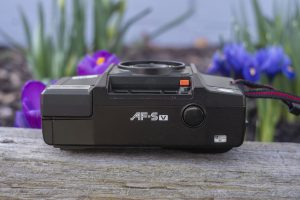
If you’ve used a similar camera like this before, you already know how to use it. The top plate is bare, save for the logo, shutter release, and automatic resetting exposure counter.
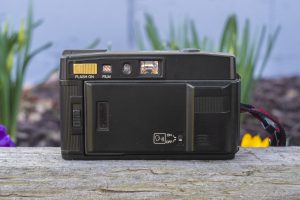
The back has a switch to manually activate the flash, film transport indicator, a flash readiness light, the eyepiece for the viewfinder, and the door release. The only thing new here that you wouldn’t see on other cameras is a switch on the door for enabling the talking feature. The camera I had to review only had options for On and Off, but I’ve seen other versions of this camera with a language selector to switch between English and Japanese.
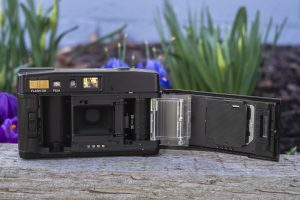
With the film door open, the film compartment shows a standard left to right film transport onto a fixed, and rubber coated take up spool, but the Talker has a nice quick load feature which uses an inner door made of clear plastic that is hinged separately from the main door. Loading film is simply a matter of extending the leader to a mark near the edge of the camera and closing the door, but unlike other point and shoots with a similar feature, you can optionally close this inner door and see if the film is aligned correctly. While I don’t think that many people had issues with misaligned film on cameras with a quick load feature, having this inner door which allows you to see it line up with the spool before closing the main door is a nice bonus.
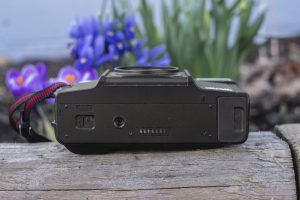
On the bottom is the battery compartment which uses two AA batteries, a 1/4″ tripod socket, the camera’s serial number, and a manual rewind option which unlike other cameras that is a simple button, the one on the Talker is in a channel shaped like the letter “L” in which you have to use a sharp object to slide it over and around a corner to activate.
There is nothing to see on either side of the camera except for the wrist strap lug on the camera’s side. My example still had it’s original black and red strap and was in good enough condition to still be useful.

Besides the talking feature, the only other distinct feature of the Minolta Talker is the lens cap, which doubles as both a power switch and shutter release lock. When the cap is on, a small metal pin right in front of the shutter release is pushed in which completely powers off the camera, preventing accidental exposure.
Beneath this pin is an orange button for activating the self timer. Press this button once, and the next time you press the shutter release, a red LED will illuminate and the camera will begin a 10 second delay before firing the shutter. I could not find any obvious way to cancel the self timer once it is set, but I also could not locate a manual for this camera, so if anyone knows, please share how in the comments.

The Talker has no manual control over shutter speeds or aperture, but it does have a small window above the lens which allows you to select what speed film you have in the camera. The Talker predates DX film encoding, so you must set it manually, but this has the benefit of a wider range of film speeds from ASA 25 to 1000 than many cameras of it’s day allow. Many 1980s point and shoot cameras are limited to just 100 or 400 speeds, with some going up to 1000, but very few as slow as ASA 25. Another benefit is that different speeds in 1/3 EV increments can be selected. Want to shoot Rollei RPX 25 or Kodak Portra 160? Just select the appropriate dot and you should have accurate exposures. Even when using standard film speeds, this allows for an element of manual exposure correction not commonly found on point and shoot cameras of the day.
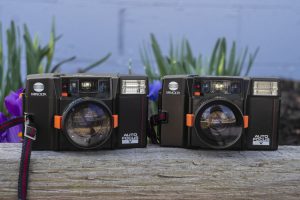
One last feature of the camera which I am not sure Minolta intended, was that with the release of both the non-talking Minolta AF-S and the Minolta Talker, came a set of aftermarket wide angle and telephoto auxiliary lenses that clip onto the camera just like the lens cap. One of the two Talkers I have come across came with a set made by Imado, but I’ve seen others online by companies like Focal and Saitex. They all look the same, so it’s highly likely these were made by the same company and sold with different names. I’ve never seen any branded by Minolta, which is why I wonder if this was a case of an ambitious aftermarket, rather than something Minolta envisioned.
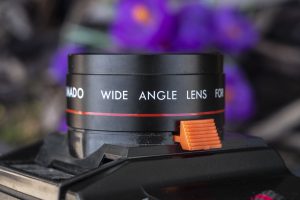
In the case of the Imado lenses, they are very cheaply made, with two glass elements that simply clip on to the body to alter the light path entering the lens. On the wide angle lens, a curved piece of plastic covers the front viewfinder window, widening the path of light entering the viewfinder to give you a supposedly accurate wide angle view. The telephoto lens does not have a piece of plastic to alter the light path, instead relying on a black frame that partially blocks the edges of the viewfinder, showing a slightly cropped image through the viewfinder. In both cases, the change in focal length is minimal. I would guess the wide angle lens changes the already semi-wide angle 35mm to about 28mm, and the telephoto changes it to about 45mm.
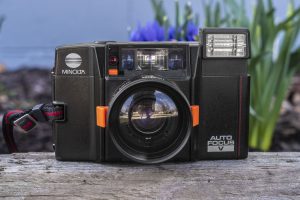
The Talker has a typical pop-up electronic flash that is activated by a slider on the back of the camera. As soon as the flash is popped up, it begins the charge. Recycle time is a good, but not great 5-6 seconds. With a slow shutter speed of 1/8 seconds, the Talker can handle a decent amount of low light situations without needing the flash, but you’ll be rewarded with both a red warning LED, along with a voice reminder of “Too Dark, Use Flash”. When the flash is no longer needed, you must manually press it down into the body to turn it off. The flash can also be used as a fill flash in daylight situations even if the meter doesn’t think it’s needed which is a nice feature to have.
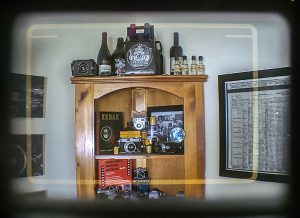
Finally, the viewfinder itself is typical of early autofocus point and shoots, showing an optical view with Albada type frame lines and manual parallax correction marks and an center oval to indicate the auto focus point. A red “slow shutter” warning LED, and green flash ready LED are the only other things visible in the viewfinder. No information about detected focus distance is given.
If you’ve made it this far into the review, by now you’re probably screaming at the screen saying “But Mike, when are you going to tell us about the things the Talker can say! In reading a variety of online reviews for this camera, most of them only mention two things the camera says, but there are in fact, three.
The first is the easiest to recreate. With the camera on and no film loaded, half press the shutter release and you’ll be greeted with “Load Film”, duuuh. The shutter will actually still fire if you press the shutter release the rest of the way though.
The second requires film to be loaded into the camera and you half press the shutter release with the flash off, the camera will warn you “Too dark, use flash”. This is effectively a camera shake warning as the shutter will still fire down to the minimum speed of 1/8 second. If the camera is stabilized on a tripod or flat surface, you can still make your exposure, but the camera will desperately want you to use the flash.
The third is the one most people miss, which is “Check Distance”. This only occurs when you have the flash on and the camera has detected a focus range beyond the reach of the flash. Focusing the camera to infinity with the flash on will give this prompt.
I have recorded the short video below of the camera saying all three prompts. Notice in the second prompt, you can see a red LED glow in the viewfinder which is a visual clue that you need to use flash. This light will still work even if the talking switch is off. In the last one, I have the camera outside pointed at a building more than 100 feet away.
So there you have it, the Minolta AF-Sv “Talker” in all it’s talking glory. It doesn’t take a 4700+ word review to realize this was a gimmicky feature “from the mind of Minolta” but as one of the few talking cameras, I think it’s pretty neat and adds to it’s appeal whereas the non-talking Minolta AF-S likely wouldn’t ever get a review on this site. Of course, talking or no talking, this is a camera and cameras need to make photos, so how does it do?
My Results
Whenever it comes time to shoot a camera for the first time, my selection of which film to use is determined by two things. First, is my level of confidence that the camera works. In the case of the Minolta Talker, while everything appeared to be working normally, fully automatic point and shoot cameras can be unpredictable and a bevy of things can go wrong, rendering a roll of film unusable. With that uncertainty, I usually reach for something I have a lot of, or some kind of expired film.
The second factor is where I’ll likely use the film. If it’s in the winter where grays and blues are common and a vivid color film could not be used to it’s strengths, I’ll usually opt for a medium to fast black and white film.
For the Talker’s first roll, I decided on an expired roll of Kodak TMax 400. While TMax generally survives well after it’s expiration date, I expected there to be some pronounced grain, but nothing too bad. Upon seeing the results that showed some pretty significant bromide drag from the sprocket holes, I decided to shoot a second roll of Eastman 5247 cinema film.
Sadly, the camera died about eight exposures into the second roll, so I developed and scanned what I could, but to add insult to injury, the film had degraded quite a bit, returning muddy, and extremely grainy images.
Not wanting to give up on the Minolta Talker experience, I picked up a second Talker which came with the clip-on wide angle and telephoto Imado lenses that you see earlier in this article. I figured with a second, working Talker and the lenses, I could finally get some nice images and show off what the auxiliary lenses could do.
Ugh. Although I managed to get through the first roll through the second Talker successfully, as it turned out, the focusing system on the camera wasn’t working and only images from about 4-6 feet were in focus. Anything shot at or near infinity was blurry.
Still, I did wide, normal, and tele tests of several scenes and while they’re all out of focus, I can still draw a few conclusions. Neither of the lenses state what their magnification rate is so I can’t say for certain what the focal length of these images are, but the effect is subtle. With the telephoto adapter on, the image still looks a little wider than 50mm, suggesting a magnification of no more than 1.2x. If that’s true, then the wide angle is likely 0.8x, resulting in images with approximate focal lengths of 28mm with the wide angle, and 43.75mm with the telephoto.
It is probably no surprise that cheap clip-on aftermarket wide angle and telephoto lenses are going to have a negative impact on image quality. In the gallery below, all three sets of images show pronounced barrel and pincushion distortion when using the Imado lenses. It is most noticeable on the set of the window flower box as the horizontal lines from the house’s shingles are dramatically bent. The images are softer, showing less contrast in the center of those images as well, and exposure seems to have been negatively affected more on the telephoto ones than the wide angle ones.
It is clear that these lenses were not developed for the discerning photo enthusiast. Any time you add extra pieces of glass in front of a camera lens, you’re going to have an impact on image quality. Had Minolta created model specific wide and tele lenses for the Talker, I am sure they would have been of higher quality, but what we have here was likely good enough for the same type of customer who a talking camera might have appealed to in 1984.
The Minolta Talker, like most auto focus 35mm point and shoot cameras from it’s era has a 4-element “Tessar-style” prime lens that when working properly, is optically good. Throughout the 1980s and 1990s, the quality of Japanese point and shoots all seemed to merge into a single “pretty good, but not spectacular” grouping of cameras and the Talker is no exception. As I’ve mentioned earlier in this article, the Talker is just the regular Minolta AF-S with the gimmicky talking feature, so in terms of image quality, the 35mm f/2.8 lens does as good a job as any other Minolta point and shoot from the era.
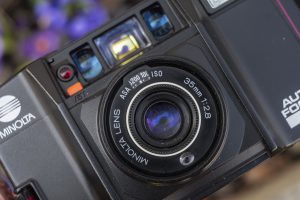
Between the three rolls I shot, the two in focus images from the TMax give us the best glimpse of the camera’s potential. Image sharpness is excellent in the center with a hint of softness and pronounced vignetting near the corners. Images from Tessar style cameras all seem to have the same look, so there’s nothing particularly distinct about what you’ll get from the Talker, but therein lies one of it’s best strengths, predictability. You can be assured that every image you shoot with this camera will come out with good sharpness, contrast, and exposure with just the slightest hint of a film like “vintage look” that people like today.
The semi-wide angle focal length means that the auto focus system does not need to work very hard as depth of field takes care of most photographic situations, and the f/2.8 maximum aperture means the camera performs respectably in limited lighting situations. Every single image I shot in the two rolls I put through the camera came our properly exposed, although to be fair, I didn’t exactly try to challenge the camera either.
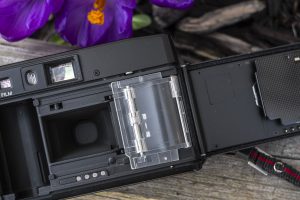
Compared to later point and shoot zoom cameras with f/4.5 and slower lenses, with it’s 1/8 second slow shutter speed the Talker can be used in greater situations without the need for flash, of course when you do need the flash, the camera gleefully reminds you!
Putting aside the talking feature, the use and my opinions of the Talker are pretty much the same of any other single focal length auto focus point and shoot camera of this era. Whether it’s made by Minolta, Nikon, Canon, Olympus, Pentax, Ricoh, or some other company, they’re all “good”. If you get a chance to pick one of these up, of course the biggest factor should be whether it works. As is the case with all electronic cameras, the perils of time are not kind to diodes, CPUs, and other electronic components, and if something has failed, you’re not likely to be able to fix it. The talking feature is neat, but it’s a good thing there is a switch to turn it off, as the novelty of it wears off quick. Still, for a simple and easy to use camera that’s going to deliver good results nearly every time you shoot it, it’s a worthwhile camera to add to your collection, just don’t over pay for it.
Related Posts You Might Enjoy
External Links
http://camera-wiki.org/wiki/Minolta_AF-Sv
https://blog.jimgrey.net/2016/06/24/minolta-af-sv-talker/
https://bryantakespictures.wordpress.com/2011/02/08/minolta-af-sv-talker/
https://petapixel.com/2017/01/12/minolta-af-s-v-talker-80s-camera-spoke/
https://www.photo.net/discuss/threads/minolta-talker-point-and-shoot.5491619/
http://web.archive.org/web/20030614200249/https://www.kitamura.co.jp/museum/05_cmp/min_af_s_talkman.html (Archived, in Japanese)


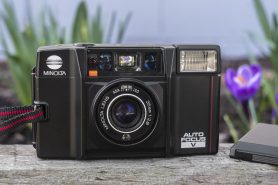
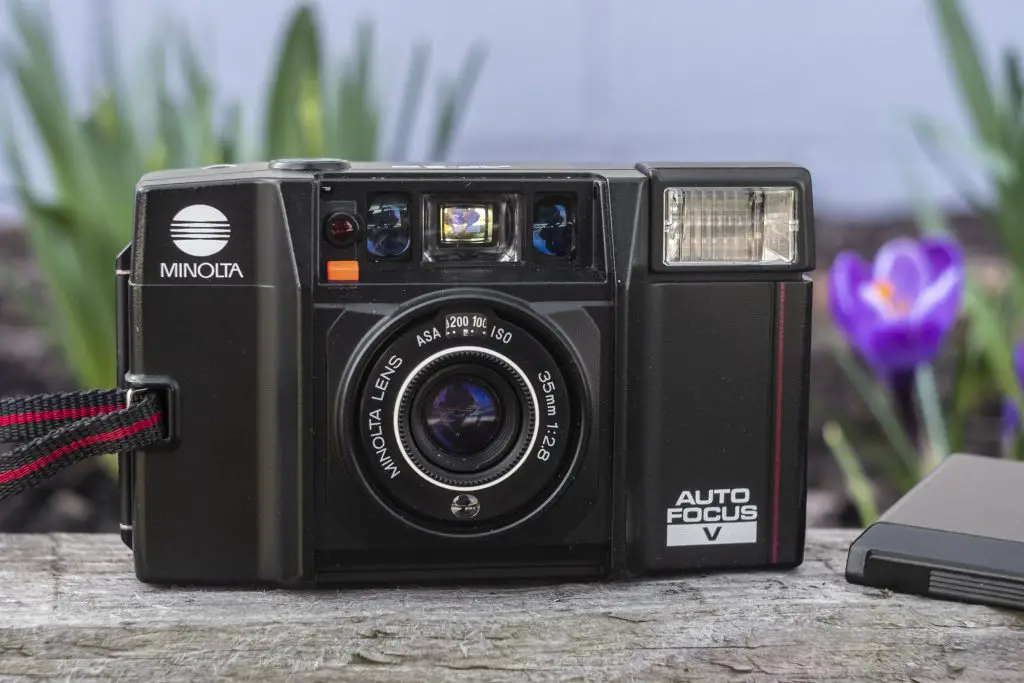















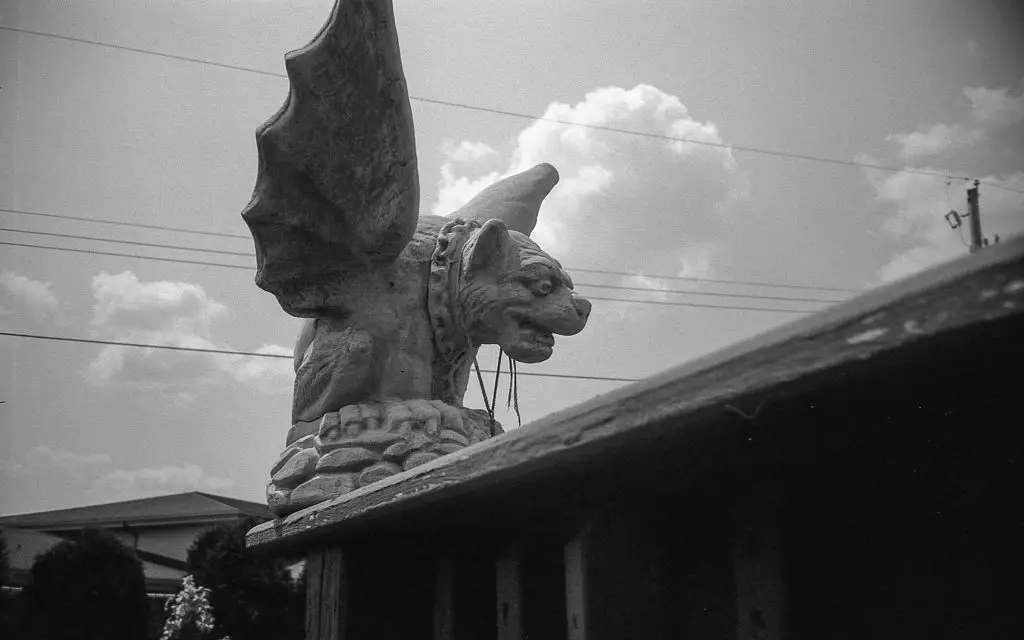
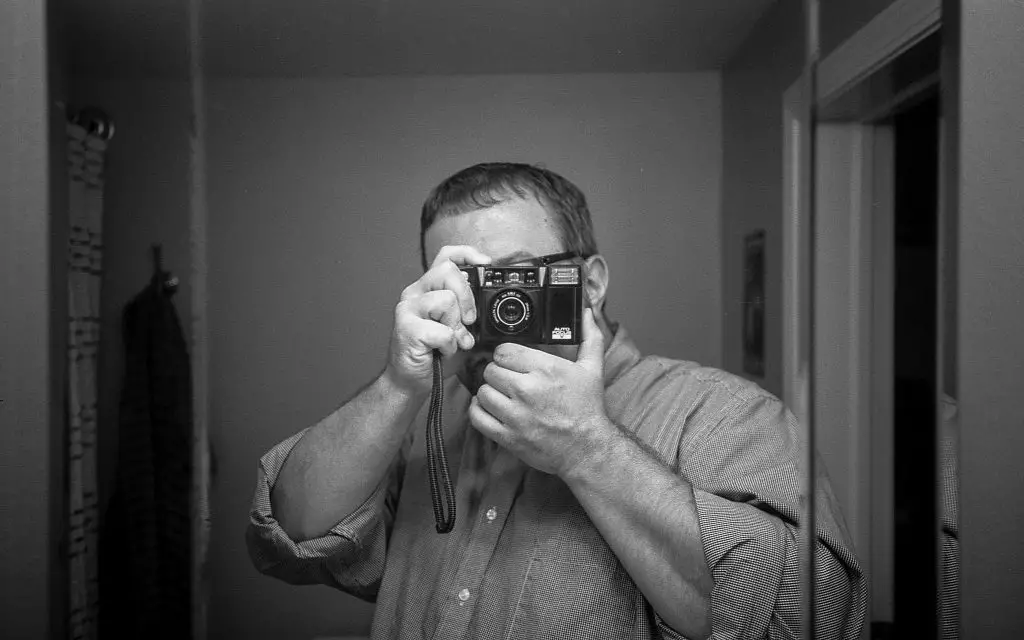

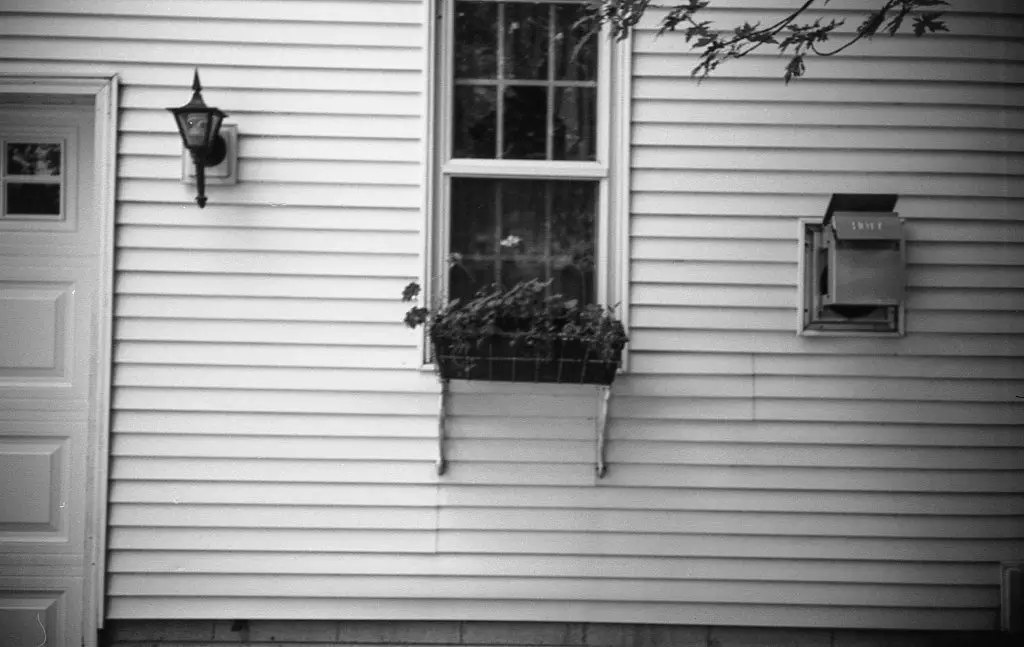
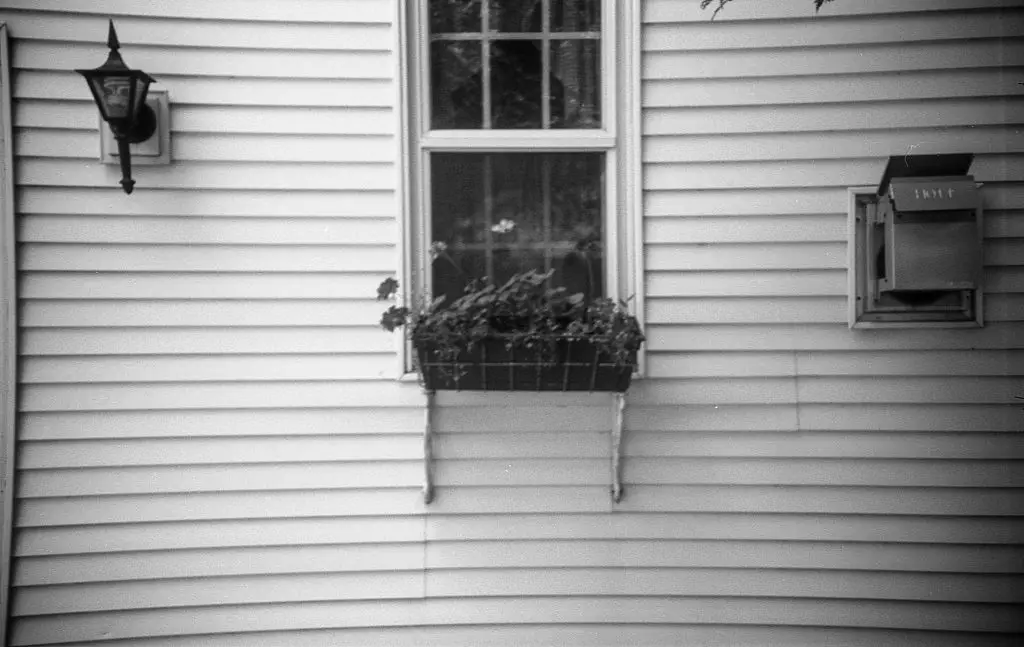
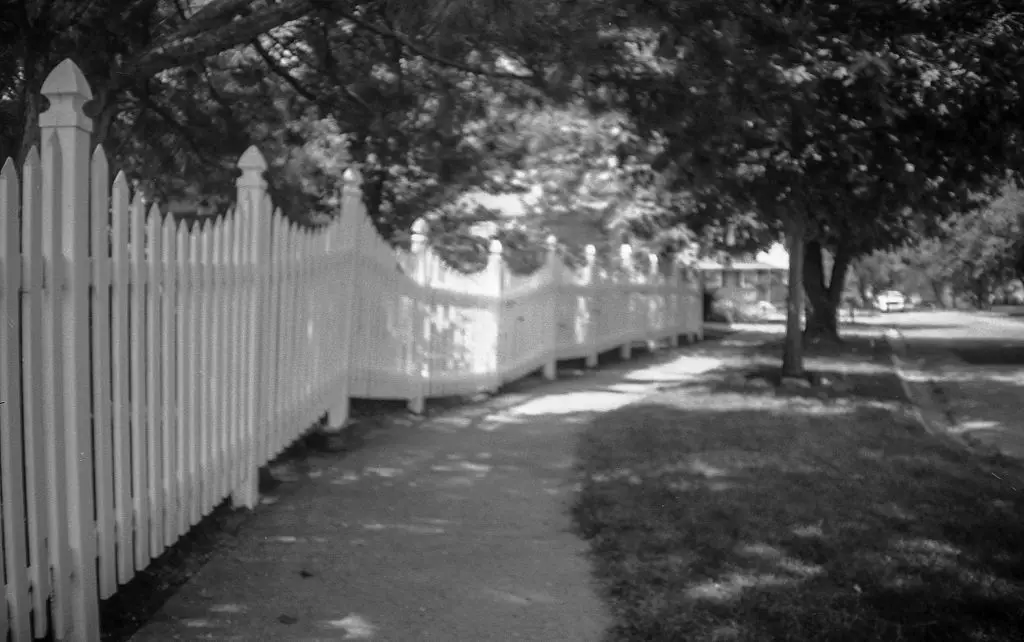

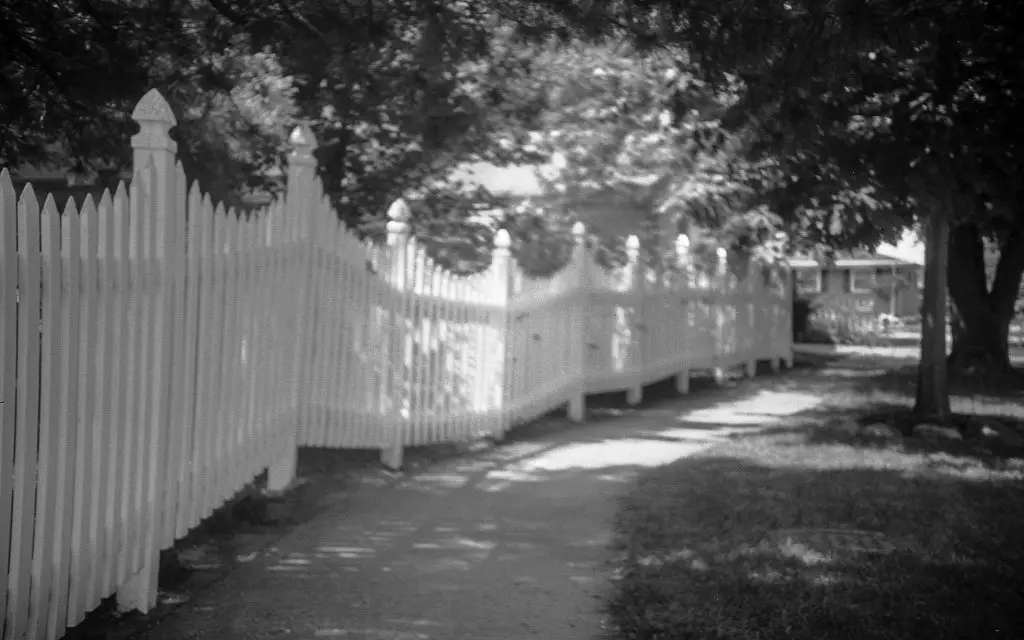
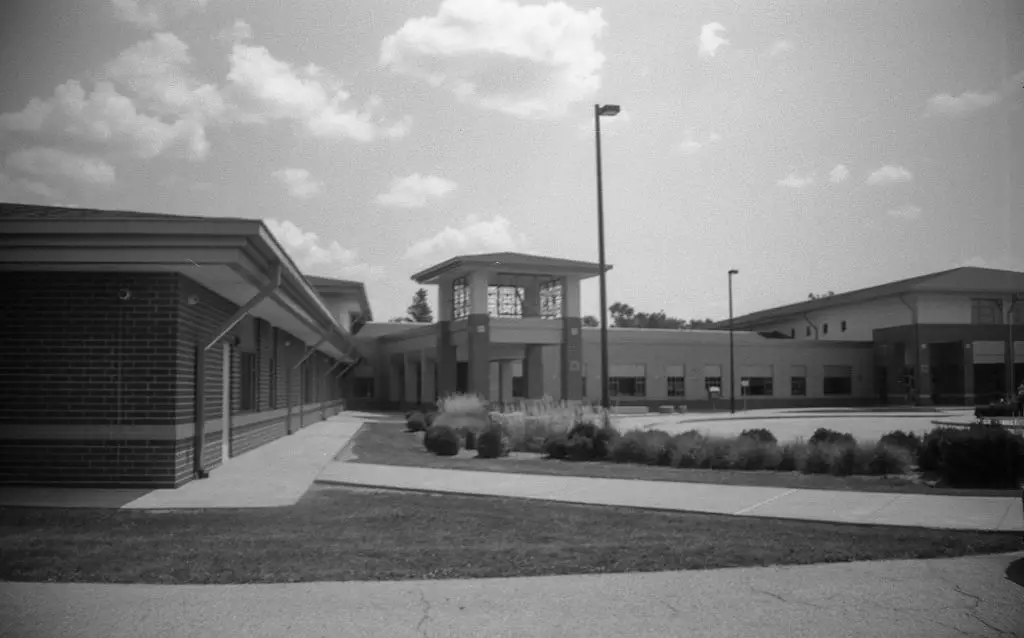
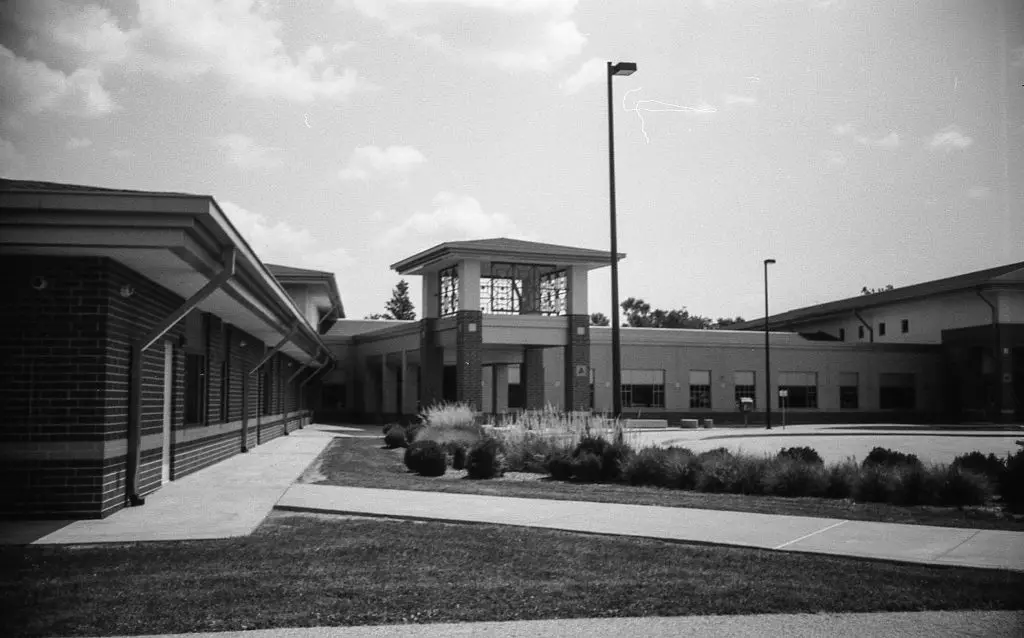

Great review as always. I have three of these Minolta AF cameras although only one’s a Talker. They were so cheap I couldn’t refuse. The image quality is very good for a p&s camera of this age and I have had no failures to date.
Hi Mike, thanks for the review. On your conclusion “…the world’s first talking camera, but without that feature, it’s just another 1980s fully automatic point and shoot 35mm camera.” I respectfully have to disagree.
It’s quite a big deal for a photographer to have a camera that can be manually set from ISO 25 to ISO 1000 and requires manual engagement of the flash. That, and the fact that its slowest speed is 1.8yh means it can be a perfect low light camera.
Load it with Tmax-400 and rate it at ISO 1000, develop in X-tol 1:3 and the results can be pretty excellent from a capable photographer
For a daft novelty feature, if you can get the talk on/off switch to stick in the middle, it’ll actually talk to you in Japanese. My understanding was that some cameras had a three position switch between Off/Japanese/English, but that ones sold outside of Japan only clicked at the Off/English positions.
I’ve heard this too, but tried it on mine and it never worked. So either it only works on some, or there’s such a very exact spot it has to be, which I was never able to get it to.